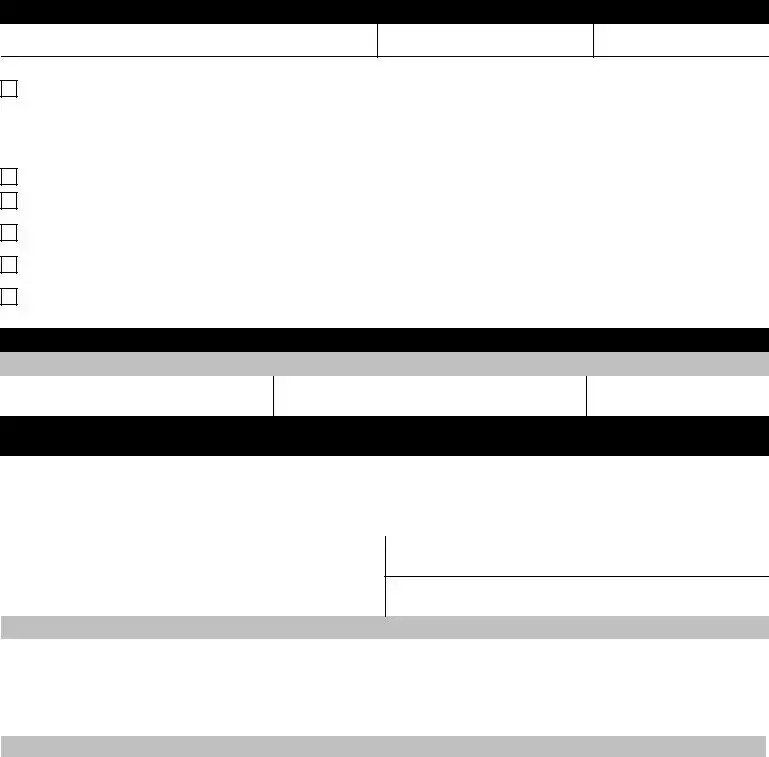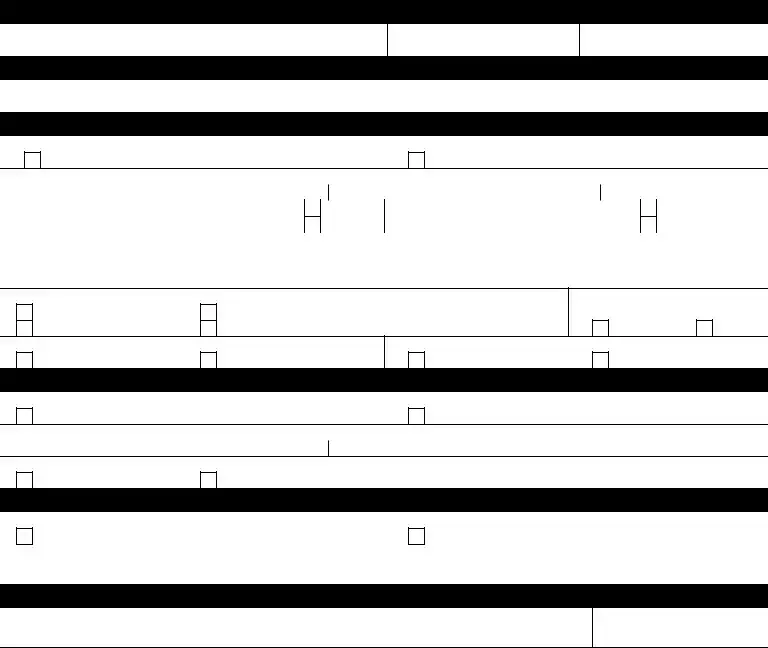Application for Deferred or Postponed Retirement
Federal Employees Retirement System
Form Approved: OMB number 3206-0190
This application is for you if you are a former Federal employee who was covered by the Federal Employees Retirement System (FERS) and you wish to apply for your retirement annuity. You should complete this application if you choose to apply for an annuity which will begin more than 1 month after your separation from Federal service (or transfer to a position not covered by FERS) and:
1.you have completed at least 5 years of creditable civilian service and are eligible for a deferred retirement at age 62; or
2.you have completed at least 10 years of creditable service, including 5 years of civilian service, and are eligible for an annuity at the Minimum Retirement Age (MRA).
Send your completed application (approximately 60 days before you want your benefits to begin) to:
Office of Personnel Management
Federal Employees Retirement System
P.O. Box 45
Boyers, PA 16017-0045
You should have received the informational pamphlet RI 92-19A, Applying for Deferred or Postponed Retirement Under the Federal Employees Retirement System, with this application. If you did not receive this pamphlet, you can access the pamphlet on our website at www.opm.gov/Forms/. You can also get a
copy by calling the Office of Personnel Management (OPM) at 1-888-767-6738 or by contacting us at the address above. If you use TTY equipment, call 1-855-887-4957.
If your address changes before you receive your claim number, write to us giving your name, date of birth and social security number. If you have received your claim number, remember to refer to it.
Instructions for Completing Application for
Deferred or Postponed Retirement
Type or print clearly. If you need more space in any section, use a plain piece of paper with your name, date of birth, and Social Security Number written at the top. If you do not know an answer write “unknown.” If you are uncertain of any information you provide, answer to the best of your ability, followed by a question mark (?).
The following information should help you to answer the questions on the application which are not self-explanatory.
Section A - Identifying Information
Item 2: List other names under which you have been employed in the Federal government (such as a maiden name). This will help us to locate and identify all your records.
Section C - Military Service
Item 1: Indicate whether you have performed active duty that terminated under honorable conditions in the armed services or other uniformed services of the United States, including the following:
�Army, Navy, Marine Corps, Air Force or Coast Guard of the United States.
�Cadet at the United States Military Academy, United States Air Force Academy, United States Coast Guard Academy, or Midshipman at the United States Naval Academy.
Item 4: Enter the address to which correspondence should be mailed. Do not enter the bank address where your payments will be deposited here; complete Section H of this application.
Section B - Federal Civilian Service
Item 2: Show the agency where you performed your last Federal service. Give the bureau and/or division as well as the name of the agency and include its location (city, state).
Item 3: List all Federal civilian service that you have performed. Give the bureau and/or division as well as the name of the agency, along with the agency’s location and the beginning and ending dates of the service.
�Regular Corps or Reserve Corps of the Public Health Service after June 30, 1960.
�Commissioned Officer of the National Oceanic and Atmospheric Administration after June 30, 1961 or a predecessor entity in function.
Excluding the National Guard, active service in the reserve components of the uniformed services, including active duty for training, is military service. Service as a National Guard member does not meet the definition of military service for purposes of civil service retirement, except when the member is ordered to active duty in the service of the United States or performs full-time National Guard duty (as such term is defined in section 101(d) of title 10) if the National Guard duty interrupts creditable civilian service under subchapter I of chapter 84 of title 5, and is followed by reemployment in accordance with chapter 43 of title 38 that occurs on or after August 1, 1990.
|
Previous editions are not usable |
Instruction Page 1, RI 92-19 |
|
Revised May 2012 |
|
|

Part 1: You must complete this section. Include your name, date of birth and social security number as shown on your application. Check the box(es) that corresponds to the selection(s) you made in Section F on your application. Check all boxes that apply.
Part 2: Your spouse completes this section, in the presence of a notary public.
Part 3: A notary public or other person authorized to administer oaths (e.g., a justice of the peace) must complete this section, after witnessing your spouse’s signature.
Schedules B & C - For Applicants Who Have At Least 10 Years of Creditable Service
If you have at least 10 years of creditable service (5 of which must be civilian) which will be used to compute your benefit, then you must complete one of these two schedules. Do not complete either of these schedules if you have less than 10 years of service.
Complete Schedule B if you had attained the Minimum Retirement Age (MRA) when you left Federal service and had at least 10 years of creditable service. You are eligible to choose when you want your benefit to begin and may be eligible to reenroll in the health benefits, life insurance and Federal Dental and Vision programs and carry them into retirement.
Complete Schedule C if you had not yet attained the MRA when you left Federal service, but you did have at least 10 years of creditable service. You are eligible to choose when you want your benefit to begin.
The MRA is based on the year of your birth and determines the earliest date you became eligible to have your retirement annuity begin. The Minimum Retirement Age Schedule is:
|
If your year of birth is: |
Your MRA is: |
|
|
Before 1948 |
55 years |
|
|
|
|
1948 |
55 years, 2 months |
|
1949 |
55 years, 4 months |
|
|
|
|
1950 |
55 years, 6 months |
|
1951 |
55 years, 8 months |
|
|
|
|
1952 |
55 years, 10 months |
|
1953 to 1964 |
56 years |
|
|
|
|
1965 |
56 years, 2 months |
|
1966 |
56 years, 4 months |
|
|
|
|
1967 |
56 years, 6 months |
|
1968 |
56 years, 8 months |
|
|
|
|
1969 |
56 years, 10 months |
|
After 1969 |
57 years |
|
|
|
|
|
|
Schedule B
Part 2: You may choose to have your annuity begin on:
1.the first day of the month following your separation from Federal service; or
2.the first day of any month which is at least 31 days after the Office of Personnel Management (OPM) receives your application for retirement (but before your 62nd birthday).
Your annuity will be reduced by 5/12 of 1% for each full month (5% per year) that the date your annuity begins precedes your 62nd birthday. You can avoid the age reduction entirely if you choose the first day of the month that you reach age 62 as your annuity commencing date. The age reduction does not apply if your annuity commences the first day of the month after your 60th birthday and you have at least 20 years of service.
Parts 3 People who leave Federal service after reaching the MRA with at least
and 4: 10 years of creditable Federal service are eligible to reenroll in the Federal Employees Health Benefits Program and the Federal Employees’ Group Life Insurance Program if they had participated in the program for the 5 years of service immediately before their separation date or continually from their earliest opportunity. If you were enrolled in either of these programs when you left Federal employment and you had already attained your MRA and had 10 years of creditable service, complete these sections. If you want information about reenrolling in either program, indicate so in item 1b.
Part 5: People who leave Federal service after reaching the MRA with at least 10 years of creditable Federal service are eligible to reenroll in the Federal Dental and Vision Insurance Program (FEDVIP). If you were enrolled in FEDVIP when you left Federal employment and you had already attained your MRA and had 10 years of creditable service, complete this section. If you want information about reenrolling, indicate so in item 1b.
Part 6: If you are enrolled in the Federal Long Term Care Insurance Program (FLTCIP), your coverage will continue. No action is required by you. However, you may choose to have your premium payments deducted from your annuity. To elect annuity deduction of premiums, please call Long Term Care Partners, at 1-800-582-3337 (TTY: 1-800-843-3557).
If you are not currently enrolled in the FLTCIP, you, your spouse, and your adult children may apply for FLTCIP coverage provided you are eligible for a deferred or postponed annuity. You may request an application by calling Long Term Care Partners, at 1-800-582-3337 (TTY: 1-800-843-3557), or by visiting www.ltcfeds.com.
Schedule C
Part 2: You may choose to have your annuity begin on:
1.the first day of the month following the month in which you reach your MRA; or
2.the first day of any month which is at least 31 days after OPM receives your application for retirement if you have reached your MRA (but before your 62nd birthday).
Reverse of Instruction Page 2, RI 92-19 Revised May 2012

Your annuity will be reduced by 5/12 of 1% for each full |
Part 3: |
If you are enrolled in the Federal Long Term Care Insurance Program |
|
|
month (5% per year) that the date your annuity begins |
|
(FLTCIP), your coverage will continue. No action is required by you. |
|
|
precedes your 62nd birthday. You can avoid the age |
|
However, you may choose to have your premium payments deducted |
|
|
reduction entirely if you choose the first day of the month |
|
from your annuity. To elect annuity deduction of premiums, please call |
|
|
that you reach age 62 as your annuity commencing date. |
|
Long Term Care Partners, at 1-800-582-3337 (TTY: 1-800-843-3557). |
|
|
The age reduction does not apply if: |
|
|
a) |
Your annuity commences the first day of the month |
|
If you are not currently enrolled in the FLTCIP, you, your spouse, and |
|
your adult children may apply for FLTCIP coverage provided you are |
|
after your 60th birthday and you have at least 20 |
|
|
|
eligible for a deferred or postponed annuity. You may request an |
|
years of service, or |
|
|
|
application by calling Long Term Care Partners, at 1-800-582-3337 |
|
|
|
b) |
Your annuity commences the first day of the month |
|
(TTY: 1-800-843-3557), or by visiting www.ltcfeds.com. |
|
after you reach your MRA and you have at least 30 |
|
|
|
years of service. |
|
|
Privacy Act and Public Burden Statement
Solicitation of this information is authorized by the Federal Employees Retirement System law (Chapter 84, title 5, U.S. Code). The data furnished will be used to determine the type of annuity awarded. The information may be shared and is subject to verification, via paper, electronic media, or through the use of computer matching programs, with national, state, local or other charitable or social security administrative agencies to determine and issue benefits under those programs. It may also be shared and verified, as noted above, with law enforcement agencies when they are investigating a violation of civil or criminal law. Executive Order 9397 (November 22, 1943) authorizes use of the Social Security Number as an individual identifier to distinguish between people with the same or similar names. Failure to furnish the requested data may delay or prevent action on the retirement application.
We estimate that this form takes an average of 60 minutes per response to complete including the time for reviewing instructions, getting the needed data and reviewing the completed form. Send comments regarding our estimate or any other aspect of this form, including suggestions for reducing completion time, to the Office of Personnel Management (OPM), Retirement Services Publications Team
(3206-0190), Washington, D.C. 20415-3430. The OMB number, 3206-0190, is currently valid. OPM may not collect this information, and you are not required to respond, unless this number is displayed.
Instruction Page 3, RI 92-19
Revised May 2012
Application for Deferred or Postponed Retirement
Form Approved: OMB No. 3206-0190
Federal Employees Retirement System
Federal Employees Retirement System
Section A - Identifying Information
1. |
Name (Last, first, middle) |
2. |
List all other names used |
3. |
Date of birth (mm/dd/yyyy) |
|
|
|
|
|
|
4. |
Address (Number, street, city, state, ZIP Code) |
5a. |
Daytime telephone number |
5b. |
Best time to reach you |
|
|
6. |
Email address |
7. |
Social Security Number |
8.Are you a citizen of the United States of America?
Section B - Federal Civilian Service
1.Date on which you separated from Federal service (mm/dd/yyyy)
2.What agency did you separate from? (Give agency, group or office)
3.List below all Federal service you have performed.
Department or Agency, including Bureau or Division
Location (City and state)
Dates of Service
From (mm/dd/yyyy) To (mm/dd/yyyy)
Section C - Military Service
1.Have you performed active, honorable service in the Armed Forces or other uniformed services of the United States? (See instructions for definition.)
2.If you have military service performed after 1956, did you pay a deposit to your former employing agency?
Not applicable, go to item 3.
2a. When did you pay your deposit for post-56 military service? (mm/dd/yyyy)
2b. To which agency did you make the payment? (Give agency, bureau or division and
location)
3.If you have performed active, honorable service in the Armed Forces or other uniformed services of the United States (see instructions for definition), complete 3a-d below and attach a copy of your discharge certificate or other certificate of active military service (if available).
|
3a. Branch of Service |
3b. Serial Number |
3c. Dates of Active Duty |
3d. Last Grade or Rank |
|
From (mm/dd/yyyy) |
To (mm/dd/yyyy) |
|
|
|
|
|
|
|
|
|
|
4. Are you receiving or have you ever applied for military retired or retainer |
4a. Was your military retired or retainer pay awarded for disability incurred in combat or |
pay (including disability retired pay)? |
caused by an instrumentality of war and incurred in the line of duty during a period |
|
of war? |
Yes, complete items 4a-4c. |
Yes, if available, attach a copy of notice of award. |
No, go to Section D. |
No |
4b. Was your military retired or retainer pay awarded for reserve service |
4c. Are you waiving your military retired pay in order to receive credit for FERS? |
under Chapter 1223, title 10, U.S. Code (formerly Chapter 67, title 10)? |
|
Yes, if available, please attach a copy of notice of award. |
Yes, see instructions for information about how to request a waiver. |
Yes, a copy of my waiver is attached. |
No |
No |
|
Office of Personnel Management |
|
RI 92-19 |
|
CSRS/FERS Handbook |
Continued on reverse |
|
Previous edition is not usable |
Revised May 2012 |
|
|
Section D - Other Claim Information
1.Have you previously filed any application under the Federal Employees Retirement System or Civil Service Retirement System (for refund, retirement, deposit, redeposit, etc.)?
Yes (Complete items 1a and 1b)
1a. Type of application
Retirement
Refund
Deposit/redeposit
Refund of excess deductions
2.Have you ever been employed under another retirement system for Federal or District of Columbia employees?
|
|
Yes (Complete below) |
|
|
|
No |
|
|
|
|
|
|
|
2a. Name of other |
2b. Dates of Service |
2c. Location of |
|
2e. Were retirement |
|
Retirement System |
From (mm/dd/yyyy) |
To (mm/dd/yyyy) |
Employment |
2d. Title of Position |
deductions withheld? |
|
|
Yes |
No |
Refunded |
|
|
|
|
|
|
|
|
|
|
|
|
|
|
|
|
|
|
|
|
|
|
|
|
|
|
|
|
|
|
|
|
|
|
|
|
|
|
|
|
|
|
|
|
|
|
|
|
|
|
|
|
|
3.Have you ever received workers' compensation from the Department of Labor because of a job-related illness or injury?
|
|
Yes, complete 3a thru 3c. |
|
No |
|
|
|
|
|
3a. Compensation Claim Number |
3b. Description of benefit |
|
Total/partial disability |
3c. Date benefits |
From (mm/dd/yyyy) |
To (mm/dd/yyyy) |
|
|
|
|
|
|
|
|
received |
|
|
|
|
|
|
|
|
|
Scheduled Award |
|
Other |
|
|
|
|
|
Section E - Marital Information
1.Are you married? If separated from your spouse, but the marriage has not ended by divorce or annulment, answer "Yes."
|
|
|
Yes (Complete items 1a thru 1f.) |
|
|
|
No |
|
|
|
|
|
|
1a. |
|
Spouse's name (Last, first, middle) |
1b. |
Spouse's date of birth (mm/dd/yyyy) |
1c. |
Spouse's Social Security Number |
|
|
|
|
|
|
|
|
|
|
|
|
|
|
|
1d. |
|
Place of marriage (City, state) |
|
1e. |
Date of marriage (mm/dd/yyyy) |
1f. |
Marriage |
|
Clergyman or Justice of the Peace |
|
|
|
|
|
|
|
|
|
|
|
performed by |
|
Other (Explain) |
|
|
|
|
|
|
|
|
|
|
|
|
|
Statement regarding |
2. |
Do you have a living former spouse(s) to whom a court order gives a survivor annuity or a portion of your retirement benefits based on |
|
|
Former Spouses |
|
your Federal employment? |
|
|
|
Yes |
|
|
|
No |
|
|
Section F - Annuity Election
Read the attached instructions before making this election.
Make your election by initialing the box beside the type of annuity you want to receive and give any other information requested. Consider your election carefully. No change will be permitted after your annuity is granted except as explained in the pamphlet Applying for Deferred or Postponed Retirement Under the Federal Employees Retirement System, RI 92-19A. If you are currently married and you do not elect maximum survivor benefits the law requires that your spouse consent to your election; therefore, you must complete Schedule A and attach it to this application.
Your election to provide a survivor annuity for a current spouse terminates upon the death of that spouse or if the marriage ends due to divorce or annulment. You are required to make a new election (reelect) within 2 years of the terminating event if you wish to reelect a survivor annuity for a former spouse or within 2 years of a post-retirement marriage to elect a survivor annuity for a spouse acquired after retirement. Continuing a survivor reduction, by itself, is not effective to reelect a survivor annuity for a spouse married after retirement or for a former spouse.
If you want to elect a partial survivor annuity for your current spouse and a survivor benefit for a former spouse, you should complete options 2 and 5 below. The total of the survivor annuities elected cannot exceed 50 percent. An election of an insurable interest survivor in option 4, is not included when determining the 50 percent maximum.
1.I choose a reduced annuity with maximum survivor annuity for my spouse named in Section E.
If you are married at retirement you will automatically receive this type of annuity unless your spouse consents to your election not to provide maximum survivor benefits. If you receive this annuity, your annuity will be reduced by 10%. The survivor's annuity upon your death will be 50% of your unreduced annuity.
2.I choose a reduced annuity with a partial survivor annuity for my spouse named in Section E.
If you choose this option, your annuity will be reduced by 5%. Upon your death, your spouse's annuity will be 25% of your unreduced annuity. You must have your spouse's consent to choose this option. Attach Schedule A showing your spouse's consent.
3.I choose an annuity payable only during my lifetime.
No current spouse survivor annuity will be paid to your spouse after your death if he or she consents to this election. If you are married at retirement, you cannot choose this type of annuity without your spouse's consent. You should initial this box if you are electing an insurable interest benefit (Box 4) for your current spouse. Attach Schedule A showing your spouse's consent. If you are eligible to continue your health benefits coverage into retirement, your spouse's health benefits coverage will terminate upon your death. In addition, your spouse will not be eligible to enroll in the Federal Long Term Care Insurance program, if he/she is not enrolled at the time of your death.
4.I choose a reduced annuity with survivor annuity for the person named below who has an insurable interest in me.
You must be healthy and willing to provide medical evidence if you choose this type of annuity.
Name of person with insurable interest
Date of birth (mm/dd/yyyy)
Office of Personnel Management |
Reverse of Page 1 |
CSRS/FERS Handbook |
RI 92-19 |
Previous edition is not usable |
Revised May2012 |
5.I choose a reduced annuity with survivor annuity for my former spouse(s) as follows:
You must attach: 1. Certified copies of divorce decrees for all former spouses for whom you elect to provide survivor annuity.
2.If you are married, attach a completed Schedule A (Spouse's Consent to Survivor Election). You cannot choose this option and provide a maximum survivor annuity for your spouse (Box 1).
Your election to provide a survivor annuity for a former spouse terminates upon the death of that spouse or the remarriage of your former spouse before age 55 (unless your marriage to the former spouse lasted for 30 years or longer).
This election when combined with an election in Box 2 cannot exceed 50% of your unreduced annuity.
Persons who completed Box 1 may not complete Box 5.
Name and address of former spouse |
Date of marriage (mm/dd/yyyy) |
Date of divorce (mm/dd/yyyy) |
Survivor annuity equal to this |
|
|
|
percent of my annuity |
|
|
Date of birth (mm/dd/yyyy) |
Social Security Number |
% |
|
|
|
|
|
|
|
|
Name and address of former spouse |
Date of marriage (mm/dd/yyyy) |
Date of divorce (mm/dd/yyyy) |
Survivor annuity equal to this |
|
|
|
|
percent of my annuity |
|
|
|
|
% |
|
|
|
|
|
|
Date of birth (mm/dd/yyyy) |
Social Security Number |
|
|
|
Total (Must equal either 25% or 50%)
Section G - Information About Your Unmarried Dependent Children
Dependent Child's Name
(First, middle, last)
Date of Birth
(mm/dd/yyyy)
Dependent Child's Name
(First, middle, last)
Date of Birth
(mm/dd/yyyy)
Section H - Payment Instructions
1.Federal benefits payments will be made electronically by Direct Deposit into a savings or checking account or by a Direct Express debit card provided by the Department of Treasury. See page 2 of the instructions for this application and RI 92-19A (Applying for Deferred or Postponed Retirement Under the Federal Employees Retirement System) for additional information. This does not apply to you if your permanent payment address is outside of the United States in a country not accessible via direct deposit.
Please select one of the following:
 Please send my annuity payments directly to my checking or savings account. (Go to item 2)
Please send my annuity payments directly to my checking or savings account. (Go to item 2)
 Please send my annuity payments to my Direct Express debit card. (Go to Section I)
Please send my annuity payments to my Direct Express debit card. (Go to Section I)
 My permanent payment address is outside the United States in a country not accessible via Direct Deposit/Direct Express. (Go to Section I)
My permanent payment address is outside the United States in a country not accessible via Direct Deposit/Direct Express. (Go to Section I)
2.Please provide information about your financial institution below.
2a. |
Financial institution routing number |
2c. Name and address of financial institution |
2b. |
Account number |
Checking |
|
|
Savings |
Section I - Applicant's Certification
2d. Telephone number of your financial institution
(including area code)
Warning
Any intentionally false statement in this application or willfully misleading statement or response you provide in this application is a violation of the law punishable by a fine of not more than $10,000 or imprisonment of not more than 5 years or both (18 U.S.C. 1001).
I hereby certify that all statements made in this application are true to the best of my knowledge and that no evidence necessary to the settlement of this claim is withheld. I have read and understand all the information provided in the instructions to this application.
Signature (Do not print) |
Date (mm/dd/yyyy) |
Office of Personnel Management |
Page 2 |
CSRS/FERS Handbook |
RI 92-19 |
Previous edition is not usable |
Revised May 2012 |
Schedule A - Spouse's Consent to Survivor Election
Instructions - Complete this schedule if you are married and do not elect a reduced annuity to provide a full current spouse survivor annuity. Complete Part 1. Have your spouse complete Part 2. Part 2 must be completed in the presence of a Notary Public or other person authorized to administer oaths. The Notary Public must complete Part 3.
Part 1 - To Be Completed By the Applicant
Name (Last, first, middle)
Date of birth (mm/dd/yyyy)
I have elected (Mark all boxes which describe the survivor elections you have made.)
A. No regular or insurable interest survivor annuity for my current spouse. I understand that:
No survivor annuity will be paid to my spouse after my death.
If I am eligible to continue my health benefits coverage into retirement, his/her health benefits coverage will terminate upon my death, and
He/she will not be eligible to enroll in the Federal Long Term Care Insurance Program (FLTCIP) after my death.
B. A partial survivor annuity for my current spouse equal to 25% of my annuity.
C.An insurable interest survivor annuity for my current spouse, but no regular survivor annuity for my current spouse. (I have completed Section F, Box 4, on my RI 92-19, naming my current spouse.)
D. A maximum survivor annuity for my former spouse ________________________________________________.
(name of former spouse)
E. A partial survivor annuity for my former spouse ___________________________________________________ equal to 25% of my annuity.
(name of former spouse)
F. A partial survivor annuity for my former spouse ___________________________________________________ equal to 25% of my annuity.
(name of former spouse)
Part 2 - To Be Completed By Current Spouse of Applicant
I freely consent to the survivor annuity election described in Part 1. I understand that my consent is final (not revocable).
Part 3 - To Be Completed By a Notary Public or
Other Person Authorized to Administer Oaths
I certify that the person named in Part 2 presented identification (or was known to me), gave consent, signed or marked this form, and acknowledges that the consent was freely given in my presence on this the __________________________ day of ______________________________________, ____________
(Month) |
(Year) |
at ____________________________________________________________________________________________ . |
|
(City, state) |
|
|
|
Signature (Do not print) |
|
Seal
Expiration date of Commission, if Notary Public (mm/dd/yyyy)
General Information
Public Law 99-335 requires that a person who is married at the time his or her retirement annuity begins must elect to provide a full survivor annuity for a current spouse, unless the current spouse consents to some other election by signing this form.
A court order which requires an annuitant to provide a survivor annuity for a former spouse is not an election and spousal consent is not required. In other words, such a court order does not require a current spouse to waive the right to a survivor annuity. The retiring employee can still elect to provide a survivor annuity for the current spouse even though the Office of Personnel Management (OPM) must honor the terms of the court order before it can honor the election for the current spouse. The current spouse may, therefore, receive a smaller annuity than elected, or none at all, unless the former spouse loses eligibility for the court-ordered survivor annuity (through the terms of the court order, remarriage before age 55, or death).
Privacy Act and Public Burden Statement
Public Law 99-335, which established the spousal consent requirement for FERS, authorizes solicitation of this information. The data furnished will be used to determine the type of annuity awarded. The information may be shared and is subject to verification, via paper, electronic media, or through the use of computer matching programs, with national, state, local or other charitable or social security administrative agencies to determine and issue benefits under those programs. It may also be shared and verified, as noted above, with law enforcement agencies when they are investigating a violation of civil or criminal law. Executive Order 9397 (November 22, 1943), authorizes the use of the Social Security Number. Failure to furnish the requested data will delay or prevent action on the retirement application.
We estimate that this form takes an average of 60 minutes per response to complete including the time for reviewing instructions, getting the needed data and reviewing the completed form. Send comments regarding our estimate or any other aspect of this form, including suggestions for reducing completion time, to the Office of Personnel Management (OPM), Retirement Services Publications Team (3206-0190), Washington, D.C. 20415-3430. The OMB number, 3206-0190, is currently valid. OPM may not collect this information, and you are not required to respond, unless this number is displayed.
Office of Personnel Management |
RI 92-19 |
CSRS/FERS Handbook |
Previous edition is not usable |
Revised May 2012 |
Schedule B - For Applicants with Immediate MRA+10 Eligibility
(who may choose to postpone)
To be completed only by applicants who were eligible for an immediate MRA+10 annuity based on having reached the Minimum Retirement Age and having at least 10 years of creditable service at separation. Read instructions carefully to determine if you should complete this schedule.
|
Part 1 - Identifying Information |
Name (Last, first, middle) |
Date of birth (mm/dd/yyyy) |
|
Part 2 - Commencing Date |
Read the instructions carefully and |
I want my benefit to begin accruing (mm/dd/yyyy) |
elect when you want your benefits to begin. |
|
|
|
Part 3 - Health Benefits Coverage
1.When you separated from service, were you enrolled (or covered as a family member) in the Federal Employees Health Benefits Program?
Yes, complete items 1a-1c.
1a. What plan were you enrolled in when you separated (if known)? |
Plan Name |
|
|
|
Enrollment Code |
|
|
|
|
|
|
|
|
|
|
1b. Do you want information on reenrolling with the |
|
Yes |
1c. Do you have a copy of your SF 2810 |
Yes, attach copy. |
|
Federal Employees Health Benefits Program? |
|
No |
|
terminating your enrollment? |
No |
|
|
|
Part 4 - Life Insurance Coverages |
|
1. When you separated from service, were you enrolled in the Federal Employees' Group Life Insurance Program? |
|
|
|
Yes (Also complete items 1a-1d). |
|
|
|
|
No, go to Part 5. |
|
1a. What coverage(s) did you have when you separated?
Basic |
Option B -- |
Additional _________# of multiples (if known) |
Option A -- Standard |
Option C -- |
Family __________# of multiples (if known) |
1b. Do you want information on starting your coverage(s) again?
1c. Did you convert your coverage(s) to a private plan?
1d. Do you have a copy of your SF 2821 terminating your coverage(s)?
Part 5 - Federal Dental and Vision Program Coverage
1. When you separated from service, were you enrolled in the Federal Dental and Vision Program (FEDVIP)?
Yes (Also complete items 1a-1b). |
No, go to Part 6. |
1a. What plan were you enrolled in when you separated (if known)? |
Plan Name |
|
1b. Do you want information on reenrolling with the Federal Dental and Vision Program?
Part 6 - Long Term Care Insurance Coverage
1. Are you currently enrolled in the Federal Long Term Care Insurance Program (FLTCIP)?
Yes. Your coverage will continue. If you want your premium payments deducted from your annuity, call the FLTCIP administrator, Long Term Care Partners, at 1-800-582-3337.
No. If you are not currently enrolled in the Federal Long Term Care Insurance Program, you, your spouse, and your adult children may apply for coverage provided you are eligible for a deferred or postponed annuity. You may request an application by contacting Long Term Care Partners, at 1-800-582-3337.
Part 7 - Applicant's Signature
Signature
Office of Personnel Management |
CSRS/FERS Handbook |
RI 92-19 |
Previous edition is not usable |
|
Revised May 2012 |
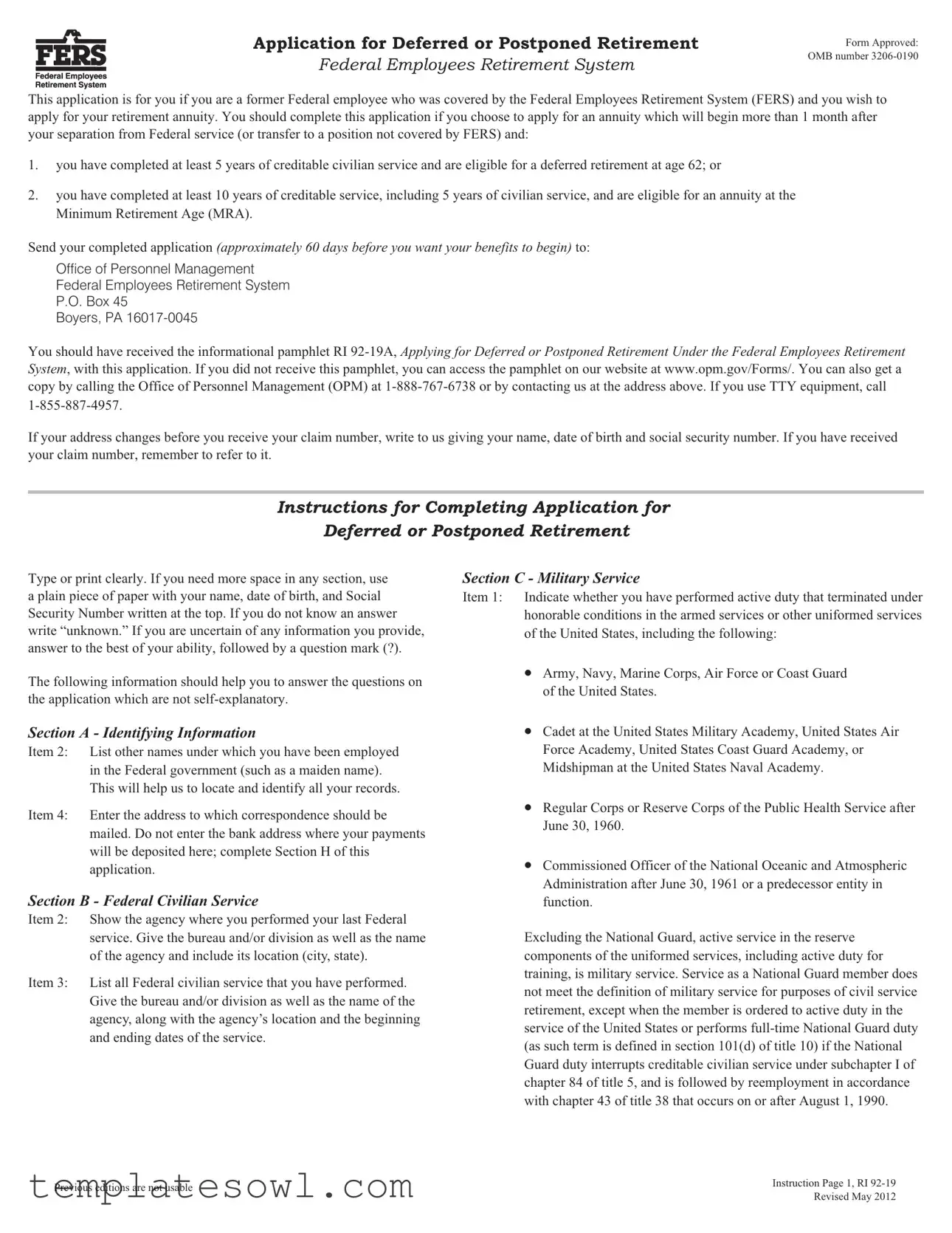




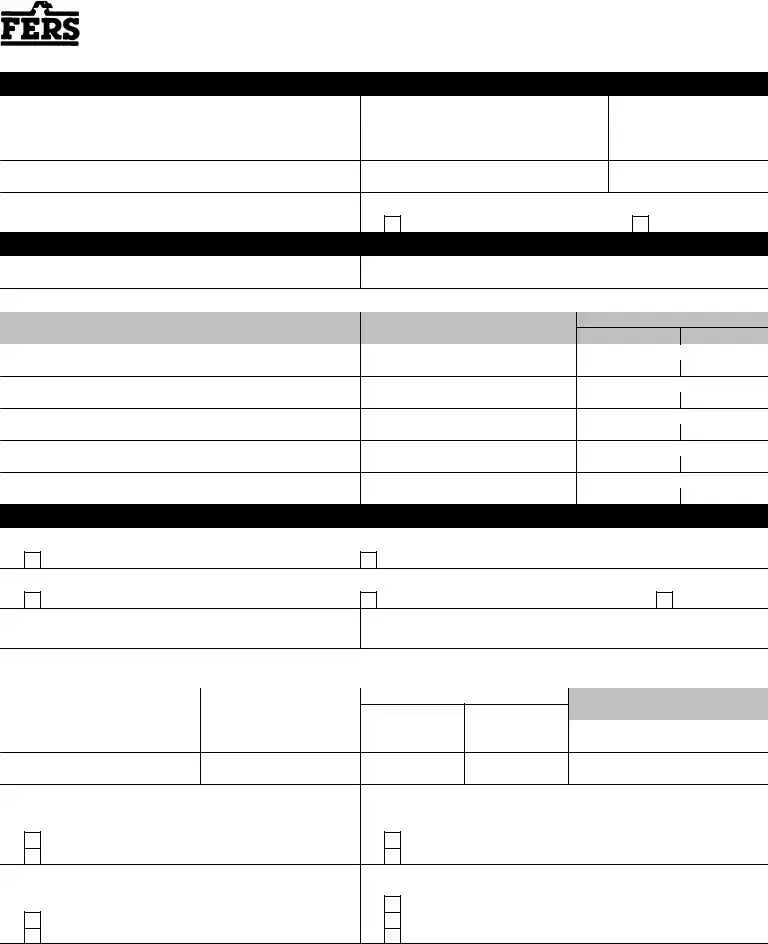
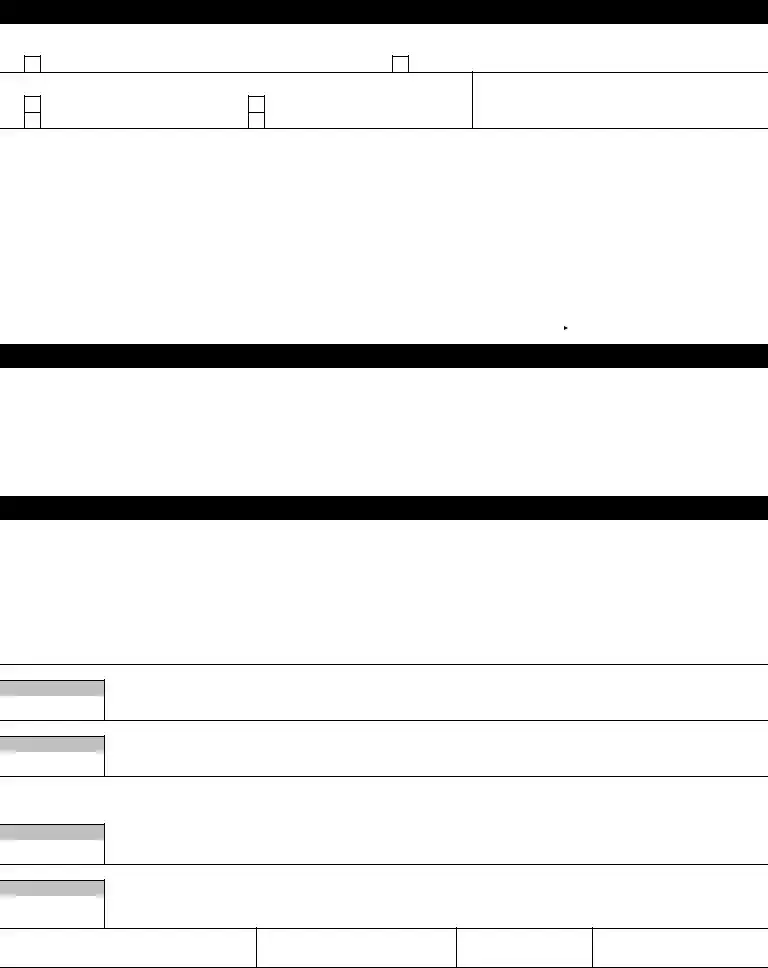
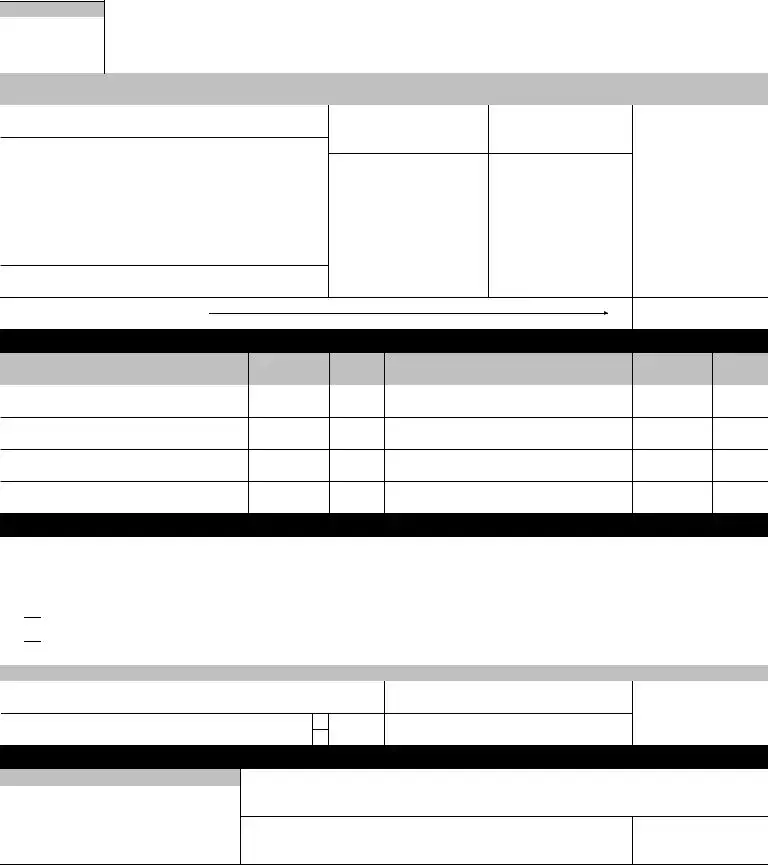
 Please send my annuity payments directly to my checking or savings account.
Please send my annuity payments directly to my checking or savings account.  Please send my annuity payments to my Direct Express debit card.
Please send my annuity payments to my Direct Express debit card.  My permanent payment address is outside the United States in a country not accessible via Direct Deposit/Direct Express.
My permanent payment address is outside the United States in a country not accessible via Direct Deposit/Direct Express. 